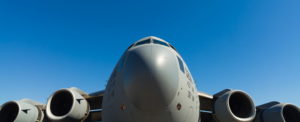
When a company like Boeing or Northrop Grumman fabricates an airplane fuselage panel from carbon fiber, they use a manual layup process that involves layering multiple pieces of carbon fiber fabric into a mold, impregnating the mold with epoxy resin, and curing the entire thing under high heat and pressure. The process works well, but composites engineers have long believed there was a better way. 3D printing may be that better way.
The U.S. Air Force, in conjunction with researchers from four different universities, have come up with a process that combines 3D printing with additive manufacturing to create carbon fiber parts without the need for manual layups and autoclave curing. If the process proves to be all that researchers believe it is, the Air Force could start fabricating its own parts in the hangar or below deck on aircraft carriers. What a game-changer that would be.
How the Current Process Works
Even while 3D composite printing is being developed around the world, aerospace manufacturers continue to use the tried-and-true process they have used for decades. They start by creating a tool for the new part they seek to fabricate. A tool is essentially a mold designed to accept carbon fiber fabric impregnated with epoxy resin.
Pieces of fabric are laid into or over the mold in multiple layers. Each layer is impregnated with epoxy resin. Once layering is complete, the entire mold is processed to evenly distribute the epoxy and remove air. This can be done through vacuum bagging or pressing. Then the mold is put into an autoclave where multiple heat cycles transform the carbon fiber fabric and epoxy resin into a carbon fiber reinforced plastic.
The process has proven effective over many years. Still, there are some inherent challenges that come with it. First, it is time-consuming and labor-intensive. Second, the process doesn’t lend itself very well to complex and nonuniform parts. Finally, it requires a lot of workspace and quite a bit of expensive equipment.
How 3D Printing Works
3D printing is a process that utilizes a printhead similar to that of an inkjet printer to lay down some sort of aggregate material in multiple layers that eventually go on to form the finished product. When adapting 3D printing to carbon fiber composites, the printhead has to accommodate a combination of carbon fibers and epoxy. It’s not as easy as it sounds.
The researchers involved in the Air Force project have developed a revolutionary direct-ink 3D printer with an integrated pressure pump capable of feeding epoxy resin through a nozzle where it is married with the carbon fiber thread. The combined material can be layered in much the same way a non-reinforced plastic is layered during the 3D printing process.
Autoclave curing isn’t necessary for these parts either, thanks to additives that allow the material to cure in place. As a result, all sorts of complex and unusual parts can be fabricated more quickly and less expensively. Any amount of space required to accommodate a 3D printer is considerably less than what manual layups and autoclave curing require.
Time will tell how well this new 3D printer performs for the Air Force. But assuming everything works out as planned, it shouldn’t be long before the Air Force is fabricating its own parts on-site. It is not unreasonable to assume 3D printers will be delivered to Air Force bases around the country as well as being deployed on aircraft carriers. The Air Force will have access to new parts on demand, regardless of where they are deployed at the time.





